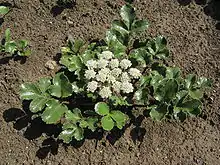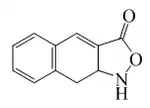Glehnia
Glehnia is a genus in the carrot family, Apiaceae, with one species, Glehnia littoralis,[1] known by several common names including beach silvertop and American silvertop in English, and bei sha shen (Chinese: 北沙參) and shan hu cai (Chinese: 珊瑚菜) in Chinese. The genus was named after Russian botanist Peter von Glehn.[2]
| Glehnia littoralis | |
|---|---|
 | |
| Scientific classification | |
| Kingdom: | |
| (unranked): | |
| (unranked): | |
| (unranked): | |
| Order: | |
| Family: | |
| Tribe: | |
| Genus: | Glehnia |
| Species: | G. littoralis |
| Binomial name | |
| Glehnia littoralis F. Schmidt ex Miq. | |
Distribution
It is native to eastern Asia, particularly eastern China, Japan, and far-eastern Russia, and western North America from Alaska to northern California.
Characteristics
It is a long-taprooted plant forming a basal patch of leaves, with each leaf made up of several rounded, lobular segments. It reaches a maximum height exceeding half a meter and its erect stem is topped with an umbel of carrotlike white flowers.
Medicinal uses
The plant is perhaps best known as a Chinese herbal remedy for cough.[3] It contains naphthisoxazole A:[4]

References
- Wu Zhengyi (1983). "On the significance of Pacific intercontinental discontinuity". Annals of the Missouri Botanical Garden. 70 (4): 577–590. JSTOR 2398977.
- "White Flowers". Netarts Bay Today http://netartsbaytoday.org. Retrieved 19 November 2009. External link in
|publisher=(help) - Tang, Weici and Eisenbrand, Gerhard Handbook of Chinese Medicinal Plants : Chemistry, Pharmacology, Toxicology, pub. Wiley-VCH 2011 ISBN 978-3-527-32226-8 Vol.1 pps. 599-600 Glehnia littoralis.
- Li G.Q.; et al. (2008). "A new isoxazol from Glehnia littoralis". Fitoterapia. 79: 238–239. doi:10.1016/j.fitote.2008.01.002.
External links
- "Glehnia littoralis". Germplasm Resources Information Network (GRIN). Agricultural Research Service (ARS), United States Department of Agriculture (USDA).
- USDA Plants Profile
- Flora of China
- Photo gallery